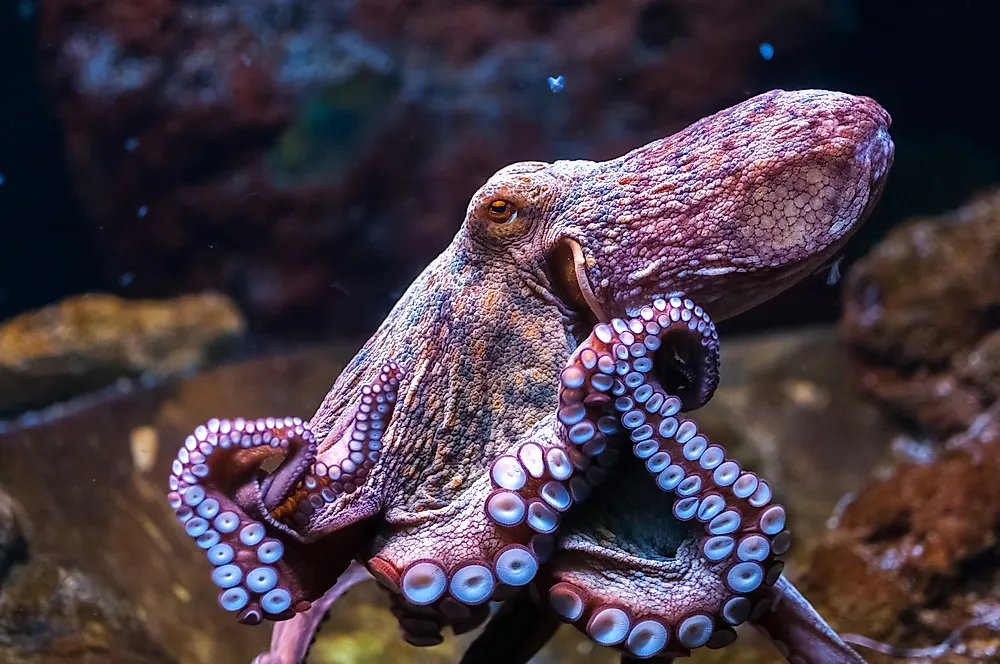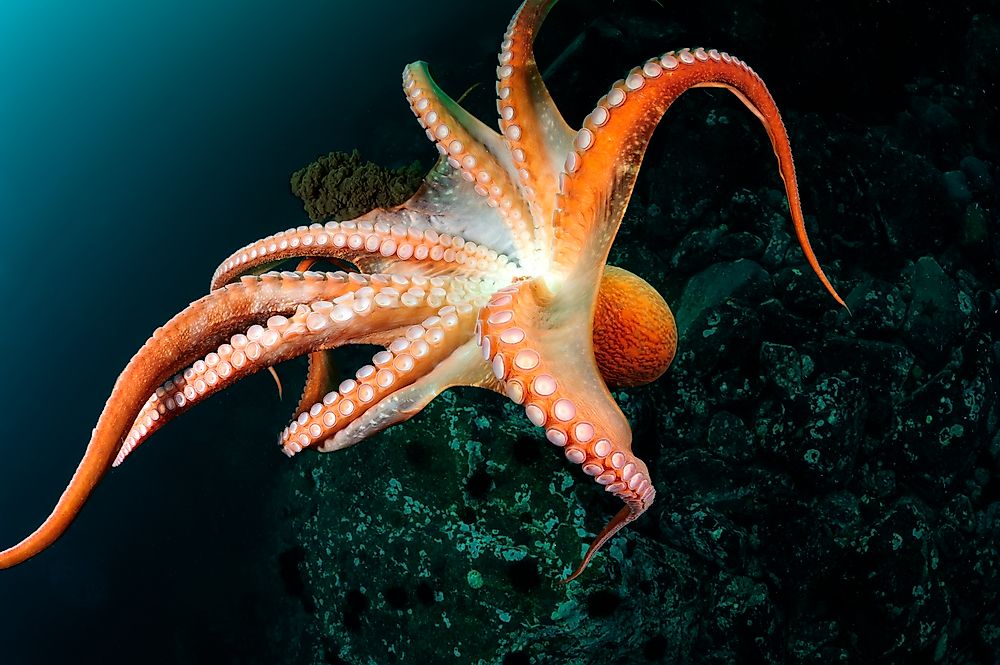Octopus Facts - Animals of the Ocean

The octopus is a sea animal famously known for its rounded body, four pairs of arms and bulging eyes. Octopus is in Cephalopoda class, Trachyteuthididae family and the order of Octopoda. This animal has a beak and a mouth that is at the center of the arms. Octopuses inhabit different regions of the ocean including ocean floor, pelagic waters, and coral reefs. These cephalopods are in two groups, the Incirrina and Cirrina. The incirrate octopus lacks filaments known as “cirri” while the Cirrina has an internal shell and two fins. The majority of octopuses are Incirrina as they have a soft body and no internal skeletons. Octopuses are famously known to have high intelligence that has led to many researchers studying their levels of memory. They have unique behaviors that are not familiar with other invertebrates.
4. Physical Description
Like the rest of the cephalopods, an octopus is bilaterally symmetric in that its body parts are along its dorsal, ventral axis. The head and its foot are in one end and functions as the front of this animal. The head typically called the mantle contains a mouth, brain, and radula. Octopus has four pairs of flexible arms attached to each other by a webbed structure. 90 percent of the body of octopuses are made of muscles and do not have internal or external skeletons. It is because of this flexible structure that they are remarkably adapted to lengthen, contract, and contort itself hence can squeeze through small openings with much ease. The mouth of an octopus contains a sharp beak on its outer part and a radula on the inside that acts like a tongue used for grinding. The interior parts of its arms have adhesive suckers that allow it grab on objects. The eyes of octopuses are large and located on top of the head.
3. Diet
Octopuses are predators that use their hard beak to bite and kill their prey. This beak is so hard that it can break on the shells of mollusks and crabs. Various species of octopuses feed on different prey but are carnivores hence eating a range of meaty foods. Their diets include fish, crustaceans, mollusks, polychaete worms, scallops, crabs, prawns and other cephalopods. Octopuses use different techniques to kill their prey including; pouncing on the prey and pulling it with arms, injecting crustaceans with paralyzing saliva before dividing it into small pieces using their beaks, and drilling holes in shells of mollusks before injecting with toxic saliva that dissolves the calcium carbonate of the shell. Most of their feeding takes place during the night.
2. Habitat and Range

Octopuses are characterized by the habitats in which they live. They are found in almost all the oceans of the world at different depths with a majority residing in the Arctic. The survival of octopus in seas and oceans is because they mostly survive in salty water. There are 300 species of these animals of which all live in oceans and seas, and none live in freshwater. Octopuses are found nearly everywhere in the marine environments from temperate to tropical waters, from coral reefs to ocean floor to coastal water. Octopuses build their nest in between rock crevices in order to hide from their predators. They are opportunistic in the place they live hence do not have a permanent place they call home. They do not stay for long in one location as they relocate in within 10 to 14 days. Octopuses also adapt to waters of different temperatures with the smaller octopus living in warmer water and the larger octopuses living in colder water. Octopus does not do very well in captivity as this brings stress to them and they will often escape when put in detention.
1. Behavior
Octopuses are creatures known to have variable behaviors. They are brilliant than any other invertebrate. They have a problem-solving capacity which biologists have experimented to show that they can store both short and long term memory. The coconut octopus has a behavior that has stood out as it is known to collect coconut shells for use as shelter. The most surprising thing is that they carry these shells around by holding with their body as they traverse the ocean floor. Octopuses are also known to manipulate tools created by humans as researchers found out that they can effectively open jars to get food. Octopuses are also characterized by their devious hunting strategies as they ambush their prey too close enough range so as to pounce on them. Since they are vulnerable to many predators including dolphins, sharks, and seals, they have defensive strategies to escape these predators. The pigment cells in their skin have an adaptation to change color hence camouflaging instantly or even squirting a dark ink that confuses their predators before going into hiding.
When octopuses are held in captivity, they have a tendency to escape their habitats. However, researchers have found these animals to exhibit playful behavior. They are also said to have aggression and hot tempers as they attack crabs immediately when they see them. Octopuses are also known to be solitary creatures and only group together during mating.
There are dangerous octopuses who produce venom that is deadly to humans. Some species are so poisonous that their toxins can kill in minutes. The only fortunate thing is that these toxic species only attack when they are provoked and taken out of the water. These types of cephalopods have sharp eyesight and can distinguish between different lights, and some species can differentiate colors.











